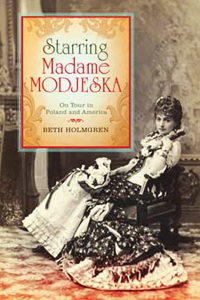by Beth Holmgren
Indiana University Press
November 10, 2011
When Helena Modjeska, Countess of Bożenta made her American debut at the California Theatre in San Francisco on August 20, 1877, few in the audience were aware of the actress’s rich past as a renowned theatre artist and celebrity of the Polish stage. Forgoing her Polish stage name Modrzejewska for the seemingly more manageable Modjeska and adding the fictitious title of Countess, Modjeska left an established theatrical career at the Imperial Theatres of Warsaw to come to the American West where she hoped to reinvent herself as an international star. Her appearance at the California Theatre that late summer of 1877 in the title role of Eugène Scribe and Ernest Legouvé’s Adrienne Lecouvreur was an important early step in this reinvention. Modjeska quickly seduced the modest San Francisco crowd with her emotive portrayal of the tragic actress’s scandalous fall from grace and ultimate murder by her chief adversary. The critics adored her and audiences flocked to the subsequent performances: Modjeska was well on her way to establishing herself as an actress capable of rivaling the likes of Sarah Bernhardt, Adelaide Ristori, and Eleonora Duse.
Beth Holmgren begins her recent biography of Helena Modjeska, Starring Madame Modjeska: On Tour in Poland and America, with a detailed account of the actress’s American debut in San Francisco, drawing attention to the impact the event had on the actress’s personal career, on late nineteenth-century American theatre in general, and on the role of the Polish émigré artist in advancing the political and cultural causes of an occupied nation. By focusing her first chapter on the launch of Modjeska’s reinvention rather than on her birth and early life in Kraków, Holmgren establishes from the start a central theme of her book: the emergence of a truly “bi-national” theatre artist who shaped the landscape of two cultures. The subsequent chapters and epilogue advance this theme by oscillating between discussions of Modjeska’s Polish and American experiences.
While the book when taken as a whole provides the reader with a clear chronology of Modjeska’s career—detailing her life in Poland before describing her journey to the U.S. and the ultimate successes and obstacles she found there—Holmgren avoids a simple progress narrative. The early chapters of the book give accounts of Modjeska’s childhood in Kraków, her training on the boards of the Polish provinces, and her ultimate blossoming on the stages of Warsaw. An entire chapter is devoted to her life in California, beginning with her arrival in 1876 with a small group of Polish artists and intellectuals and their dream of establishing a self-sustaining utopian colony in Southern California. The reader is given a thorough report of her transcontinental tours of the U.S, which helped her nurture a dedicated fan base and created opportunities for her to work with some of the most renowned American actors, including Edwin Booth and Otis Skinner. Other chapters work more thematically. One looks specifically at the diverse roles Modjeska played both inside and outside Poland—parts which include Shakespeare’s Juliet, Ophelia, and Rosalind; Dumas fils’s Camille; and Wyspiański’s Laodamia. Another examines the actress’s complex relationship to her Polish identity. This includes an account of her rousing speech at the1893 Chicago Columbian Exposition that addressed the role of Polish women in the liberation of Poland, as well as a description of her financial support of the lower-class Polonia in the United States whose immigrant experience of economic struggle and prejudice was markedly different from Modjeska’s own.
Starring Madame Modjeska offers insight into not only the prodigious life of a captivating actress who crafted her own unique romantic acting style as well as her public persona; it also provides a colorful portrait of the nineteenth-century theatre. Modjeska is shown navigating her way through entrenched star systems both in North America and Europe, which required she market herself as an international phenomenon if she wished to continue to play the great roles of her generation. The physical, emotional, and financial strains of her profession are vividly illustrated in detailed portraits of her personal life. Madame Modjeska is both a unique woman with extraordinary talent as well as a representative of the hardworking artists that helped redefine the terrain of the modern theatre.
Despite the incredible impact Helena Modjeska had on nineteenth-century U.S. and Polish theatre, few studies of her life and work have been published in English. A significant amount of Polish scholarship exists, but as Holmgren points out in her epilogue, much of this work attends to Modjeska’s life in Poland and often diminishes her U.S. experiences. Starring Madame Modjeska, therefore, makes an important contribution to our understanding of Western theatre history. Scholars as well as theatre enthusiasts will surely benefit from this well-organized and meticulously researched study of a true international star of the nineteenth century.
CR





Pingback: Welcome to Summer 2015!